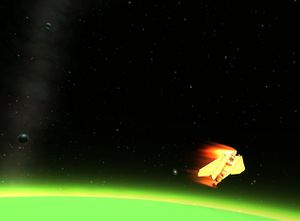Difference between revisions of "Atmospheric entry"
m (XZise moved page Re-entry to Atmospheric entry: official name) |
(*rewritten to explain more and making clear that it is quite harmless;) |
||
| Line 1: | Line 1: | ||
| − | + | [[File:19Aerobrake.jpg|thumb|Effects of atmospheric entry in [[Jool]]'s atmosphere]] | |
| − | + | '''Atmospheric entry''' is the process of a [[Craft|spacecraft]] or other object entering the [[atmosphere]] of a [[celestial body]]. It is most commonly used when referring to the re-entry of [[Kerbin]]. | |
| − | |||
| − | == | + | == Naming == |
| − | + | The scientific correct term is ''atmospheric entry'' and applies to all bodies with an atmosphere. ''Re-entry'' is only used when a craft enters the atmosphere of the body it started from. As all craft started from Kerbin it is only correct for entering Kerbin's atmosphere. Colloquially the term ''re-entry'' or ''reentry'' is used for all atmospheric entries. [[Aerocapture]]s can be treated as atmospheric entries, although a atmospheric entry usually describes slowing down in the atmosphere to assist in the landing. | |
| − | == | + | == Appearance == |
| − | + | The atmospheric entry can first be detected then the velocity starts dropping although the craft is falling and the [[periapsis]] is still ahead. As soon as the craft sinks far enough into the atmosphere that the drag is building up effects can be seen which look like flames. Those effects were added in {{Version|0.19.0}}. | |
| − | =[[ | + | == Dangers for the craft == |
| − | With their protective spacesuits, [[ | + | Although those flames appear dangerous and atmospheric entry is often the most dangerous point of missions in the real world they are usually quite harmless in Kerbal Space Program. Those effects are merely cosmetic and in the stock game the drag induced by the atmosphere can only destroy not-retracted [[solar panel]]s. As the [[OX-STAT Photovoltaic Panels]] can't be retracted they don't need to be saved. The rest of the craft won't break apart during entry. If returning to [[Kerbin]] then might be fun to watch, but it can be a danger to probes on other bodies. In extreme cases, it is possible for solar panels without the protective casing to be destroyed despite being retracted, though this only occurs on [[Eve]]'s dense atmosphere. |
| + | |||
| + | With their protective spacesuits, [[Kerbal]]s can survive entering the atmosphere. Of course, they will be completely obliterated once hitting the ground. | ||
| + | |||
| + | A spacecraft can be easily obliterated during atmospheric entry if [[physics warp]] is activated. It is advised not to activate physics warp with a [[Parachute|parachuting]] ship until the chute opens. Parachutes that have opened can survive three times physics warp on [[Kerbin]]. | ||
| + | |||
| + | == See also == | ||
| + | * {{Wikipedia}} | ||
| + | |||
| + | [[Category:Physics]] | ||
Revision as of 17:15, 3 March 2014

Atmospheric entry is the process of a spacecraft or other object entering the atmosphere of a celestial body. It is most commonly used when referring to the re-entry of Kerbin.
Naming
The scientific correct term is atmospheric entry and applies to all bodies with an atmosphere. Re-entry is only used when a craft enters the atmosphere of the body it started from. As all craft started from Kerbin it is only correct for entering Kerbin's atmosphere. Colloquially the term re-entry or reentry is used for all atmospheric entries. Aerocaptures can be treated as atmospheric entries, although a atmospheric entry usually describes slowing down in the atmosphere to assist in the landing.
Appearance
The atmospheric entry can first be detected then the velocity starts dropping although the craft is falling and the periapsis is still ahead. As soon as the craft sinks far enough into the atmosphere that the drag is building up effects can be seen which look like flames. Those effects were added in version 0.19.0.
Dangers for the craft
Although those flames appear dangerous and atmospheric entry is often the most dangerous point of missions in the real world they are usually quite harmless in Kerbal Space Program. Those effects are merely cosmetic and in the stock game the drag induced by the atmosphere can only destroy not-retracted solar panels. As the OX-STAT Photovoltaic Panels can't be retracted they don't need to be saved. The rest of the craft won't break apart during entry. If returning to Kerbin then might be fun to watch, but it can be a danger to probes on other bodies. In extreme cases, it is possible for solar panels without the protective casing to be destroyed despite being retracted, though this only occurs on Eve's dense atmosphere.
With their protective spacesuits, Kerbals can survive entering the atmosphere. Of course, they will be completely obliterated once hitting the ground.
A spacecraft can be easily obliterated during atmospheric entry if physics warp is activated. It is advised not to activate physics warp with a parachuting ship until the chute opens. Parachutes that have opened can survive three times physics warp on Kerbin.
See also
- Atmospheric entry on Wikipedia